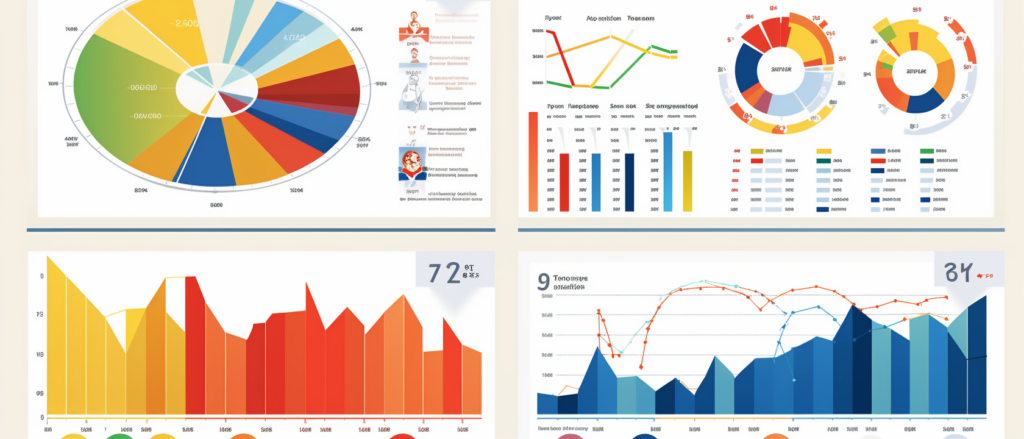Key Takeaways
✅ Define Clear Goals and Objectives: A successful marketing campaign starts with clarity. By setting specific, measurable goals and objectives, you're laying the groundwork for success. Research shows that marketers who set goals are 376% more likely to report success. Establishing SMART goals or utilizing objectives and key results (OKRs) can steer the selection of meaningful KPIs and streamline progress tracking.
✅ Track Relevant KPIs: Not all metrics are created equal. Choosing the right KPIs that align with your specific goals can make or break your marketing strategy. For instance, if conversions are your aim, monitor your conversion rate closely. Companies that measure ROI are 1.6 times more likely to have a higher marketing budget next year, emphasizing the need for precise KPI tracking.
✅ Regularly Measure and Analyze Performance: Consistent measurement and analysis are your tickets to an adaptive and responsive marketing campaign. Only 44% of marketers measure their campaigns' performance over time, missing out on crucial insights. Regular check-ins allow for course correction and optimization, ensuring your strategies stay competitive and results-driven.
![]()
Introduction
In today's competitive business landscape, the ability to measure and understand your marketing performance is crucial for success. Marketing metrics, Key Performance Indicators (KPIs), and effective KPI tracking provide valuable insights into how well your marketing strategies are working. These tools enable businesses to assess the effectiveness of their campaigns, make data-driven decisions, and continuously refine their approaches to achieve better results. By leveraging these metrics, companies can ensure they are meeting their objectives, optimizing their marketing spend, and ultimately driving growth.
Marketing metrics and KPIs go beyond just tracking sales or website traffic. They encompass a wide range of indicators that reflect various aspects of marketing performance, such as customer engagement, brand awareness, lead generation, and conversion rates. Implementing a robust KPI tracking system allows businesses to monitor these indicators in real-time, identify trends, and respond promptly to any changes in the market. This proactive approach not only helps in achieving short-term goals but also plays a significant role in long-term strategic planning and sustainable business growth.
Top Statistics
| Statistics | Insight |
|---|---|
| Consumer Online Product Searches: 87% of consumers start their search online. | This demonstrates the critical need for businesses to optimize their online presence and search engine strategies. |
| Key Marketing Metrics: Focus on brand awareness, engagement, conversion rates, clickthrough rates, and ROI among others. | These metrics are fundamental in gauging the effectiveness of marketing campaigns and guiding strategic decisions. |
| Marketing KPI Examples: 19 key performance indicators including ROI, ROAS, and customer lifetime value (CLV) are used to assess success. | Tracking a wide array of KPIs can provide a comprehensive view of campaign performance and areas for improvement. |
| Forecasted Trends: Continued reliance on KPIs and metrics for optimizing marketing strategies is anticipated. | As data analysis remains pivotal in marketing, understanding and leveraging KPIs will be the backbone of future campaign strategies. |
| Multi-channel Metric Tracking: Importance is placed on tracking metrics across various channels. | Having a multi-channel approach ensures that no aspect of a marketing campaign is overlooked, creating a holistic view of performance. |
Understanding Key Performance Indicators (KPIs)
Key performance indicators (KPIs) are the compass by which marketers navigate the vast sea of data, aiming to understand which marketing strategies float—or sink—when it comes to impacting the bottom line. So, what exactly are KPIs in the context of marketing? Simply put, they are measurable values that show how effectively a company is achieving key business objectives. Marketers routinely track KPIs like conversion rate, return on investment (ROI), and brand awareness to gauge their campaign prowess. By setting clear targets, KPIs serve as mile markers on the road to marketing victory, ensuring that even the smallest campaigns stay aligned with bigger business aims.
Types of Marketing Metrics
Diving into the world of marketing metrics, we find an array of measures each telling its own story about campaign performance. From web & SEO metrics that account for total visits and pageviews, to email metrics that may track open rates and click-through rates, each kind of metric serves a specific purpose. Take for instance social media metrics, where engagement rates and follower growth are scrutinized, or pay-per-click metrics, which focus on cost per click and ad position. Tracking these data points is fundamental to understanding audience behavior, tweaking campaign elements, and enhancing overall performance.
Defining and Tracking KPIs
The crux of clever marketing is not just in setting KPIs, but in defining ones that truly resonate with your campaign goals. Picking the right KPIs is a strategic art form—it's about ensuring that every metric you track is relevant to what you're trying to achieve. Once chosen, aligning these KPIs with established benchmarks helps in tracking progress and maintaining the course toward desired outcomes. With cutting-edge tools like Google Analytics and various social media analytics platforms, marketers can now capture real-time data to make informed decisions swiftly.
Measuring Campaign Success
How do marketers decipher if their campaign was a blockbuster or a flop? Enter KPIs, your code to unlock insights on campaign efficiency. When looking at ROI or return on ad spend (ROAS), we're scrutinizing the financial viability of marketing efforts. In contrast, metrics like customer lifetime value and conversion rate paint a picture of the campaign's long-term impact and its effectiveness at persuading actions. But truly savvy marketers know that campaign measurement is not a one-off task; rather, it requires continuous observation and fine-tuning to keep campaigns performing at their peak.
Best Practices for KPI Tracking
Data can be overwhelming, but KPI dashboards are a lifesaver, offering an at-a-glance view of performance and turning numbers into actionable insights. Smart selection and use of measurement tools are just as important as tracking the data itself. To avoid getting lost in the analytics weeds, marketers are turning to goal-setting frameworks like OKRs (Objectives and Key Results) or SMART goals (Specific, Measurable, Achievable, Relevant, Time-bound) to maintain clarity and focus amid the data deluge. Thriving in today's data-rich marketing landscape means harnessing these practices to remain on target and agile.
In setting the course for marketing success, the compass of KPIs and metrics is indispensable. With them, marketers can chart a course towards tangible results, adjusting sails as needed, to ensure that every campaign navigates towards business success. Whether you're just starting to dip your toes into marketing analytics or you're already swimming in data, an informed approach to KPI tracking is the life raft that keeps your marketing efforts buoyant in the competitive business ocean.
AI Marketing Engineers Recommendation
Recommendation 1: Focus on Customer Lifetime Value (CLV) to Drive Sustainable Growth: Data shows that increasing customer retention by just 5% can boost profits by 25% to 95%. By measuring CLV, you paint a clear picture of how valuable a customer is to your business over an extended period, rather than just the first purchase. To capitalize on this, implement tracking systems that monitor customer interactions over time. Analyze the data to determine which marketing channels are bringing in the customers with the highest CLV. This analysis allows you to understand which strategies are most effective in retaining valuable customers. Reallocate your marketing spend towards these high CLV channels for better long-term returns, ensuring your investment is focused on the most profitable customer segments. This approach not only enhances profitability but also builds stronger customer relationships and loyalty.
Recommendation 2: Leverage the Power of Attribution Modeling for a More Accurate Picture of Marketing Impact: In today's multifaceted digital landscape, it's essential to understand which touchpoints contribute to conversions. Reports show that businesses using multichannel attribution have seen a 15-30% increase in media efficiency. Stay ahead by choosing an attribution model that aligns with your business goals, whether it's last-click, linear, or time-decay. Continuously collect and feed data into your chosen model to evaluate the success of each touchpoint. This ongoing analysis helps you identify the most influential interactions in your customer journey. Regularly review and adjust your strategy based on the insights provided by the attribution model to optimize your marketing mix. By understanding the true impact of each marketing effort, you can allocate resources more effectively and improve overall campaign performance.
Recommendation 3: Adopt a Comprehensive KPI Dashboard Tool to Monitor Real-Time Results and Trends: Utilizing a KPI dashboard provides a clear view of your marketing efforts' performance, allowing quick pivots and informed decisions. According to recent surveys, marketers who check their KPIs regularly are 1.3 times more likely to meet their goals. To stay on top, select a KPI dashboard tool that integrates with all your marketing platforms and presents data cohesively. This integration ensures you have a holistic view of your marketing activities. Customize your dashboard to display the KPIs most critical to your business objectives, ensuring you're not distracted by vanity metrics. Use the dashboard to share insights across teams, fostering a data-driven culture and promoting collective action towards common goals. This real-time visibility into performance metrics enables you to respond swiftly to market changes and optimize your strategies effectively.
Relevant Links
- Discover the Path to Success with WeChat
- Dominate Short-Video Platforms in China
- Exclusive Insights on South Korea's Video Marketing Trends
- Leading SEO Strategies for South Korea's E-Commerce
- Stay Ahead: Chinese Consumer Trend Insights for 2024
Conclusion
In wrapping up our journey through the maze of marketing metrics and KPI tracking, it's crystal clear how crucial these tools are in pinning down the success of our marketing maneuvers. Have you ever wondered how brands manage to seem like they're reading your mind? That's because they're proficient in the language of numbers and trends, honing in on what works and what doesn't.
Think of KPIs as your marketing compass—they don't just tell you where you're going, they also show you the best route to take. Whether it's through the eyes of conversion rates or the storytelling of ROI, these indicators shed light on the areas that need your attention and celebrate your wins along the way. But let's be real, diving into the data ocean without a clear vision can leave you treading water. That's why it's paramount to pinpoint what's really relevant to your company's goals. Are you all about brand awareness, or is customer engagement your main jam? Selecting metrics that align with your objectives is like choosing the right spices for a dish—it's what brings your strategy to life.
Remember, tracking K new customers, though, a robust set of KPIs helps you steer the ship toward growth and profitability with confidence. When done right, the practice of KPI tracking isn't just about numbers; it's about nurturing a story of success, learning, and progress. So, are you ready to turn those stats into strategies and take your brand to the next level? The road to marketing mastery is paved with the benchmarks you set, the metrics you measure, and the insights you glean along the way.
FAQs
Question 1: What are marketing metrics and KPIs?
Answer: Marketing metrics are ways to measure how well your marketing campaigns are doing. Key Performance Indicators (KPIs) are the important numbers that show if you're reaching your goals.
Question 2: Why are marketing metrics and KPIs important?
Answer: They tell you if your campaign's winning or not, what's working and what's not, and better yet, how you can improve and make smarter choices in the future.
Question 3: How do you measure brand awareness?
Answer: You figure out how well people know your brand by asking them directly, seeing how often your name pops up on the internet, and keeping an eye on how much and where you're being talked about online.
Question 4: What are MQLs, SQLs, and SALs?
Answer: Think of MQLs as potential customers who seem just right for what you're selling. SQLs are those MQLs who get closer to buying something. SALs are MQLs that the marketing folks have checked out and said, "Yep, let's talk more."
Question 5: How do you calculate customer retention?
Answer: It's like counting who stayed with you over time. You take the number of customers you ended up with, remove the new faces, and then see how that stacks up against who you started with at the beginning.
Question 6: How do you choose the right KPIs for a campaign?
Answer: You pick the ones that match what you're trying to do. Want to reach more people? Look at website visitors. Want to sell more? Check purchases. And make sure your goals are clear and reachable (like hitting 10,000 visitors a month).
Question 7: What tools can be used for measuring marketing campaign performance?
Answer: There's a bunch, like Google Analytics for checking your website, social media analytics to see how you're doing on Facebook or Twitter, and other tools that make it easy to see if you're hitting your marks.
Question 8: How do you create a measurement schedule?
Answer: Set a calendar. Decide when you'll check in on your campaign. Could be every week, every month – the timing should make sense for your goals. And look at your past successes (or oopsies) to help you along the way.
Question 9: What are some common marketing metrics and KPIs?
Answer: You've got ROI, which tells you if you made your money back, conversion rate to see if people did what you hoped they'd do (like sign up or buy), and lots more like how many stick around (that's retention) or how much it costs to get a lead.
Question 10: How do you track marketing campaign performance across different channels?
Answer: Each channel is its own beast. You've got your website stats, how well your emails are doing, social media numbers, what's happening with your ads online, and any events you pull off – they all have their own way of telling you if it's thumbs up or thumbs down.
Academic References
- Indeed. (2020). How to Measure Success of a Marketing Campaign With Metrics. This article delves into the critical role of metrics such as Return on Investment (ROI), Cost per Lead, Cost per Conversion, and Customer Acquisition Cost in gauging the effectiveness of marketing initiatives.
- Precision Campus. (2021). 29 Key Performance Indicators (KPIs) for Colleges & Universities. In this comprehensive article, Precision Campus lays out a robust selection of KPIs tailored for higher education institutions that span student achievement, admissions, enrollments, and staff proficiency, stressing the significance of pinpointing and keeping track of the most telling KPIs to quantify outcomes and establish value.
- Reddit Users. (2019). What Standard Marketing KPIs/Metrics Do You Guys Track? Within this lively Reddit forum, marketers discuss a wide array of KPIs they rely on, including organic traffic, pipeline contribution, returning attendees, and on-demand video views, underscoring the imperative of defining lucid objectives and leveraging KPIs to chart progress toward these aims.
- Smartsheet. (2018). How to Measure Marketing Campaign Effectiveness. Smartsheet's article provides a succinct yet detailed guide for evaluating marketing campaign success, recommending clear-cut strategies like setting definitive goals, choosing the right metrics, constructing a reporting blueprint, and methodically amassing and scrutinizing data. It offers an extensive list of metrics pertinent to varied campaign objectives such as brand awareness, lead generation efforts, sales and revenue, customer engagement, and beyond.
- Higher Education Marketing. (2019). Metrics to Measure the Success of Your Education Content Marketing Strategy. Higher Education Marketing zeros in on specific metrics suitable for tracking the performance of content marketing techniques within the academic sector, highlighting conversion rates, page value, search outcomes, and lead generation metrics. It accentuates the necessity to monitor, evaluate, and fine-tune these metrics over time in order to refine strategies and validate return on investment (ROI).











